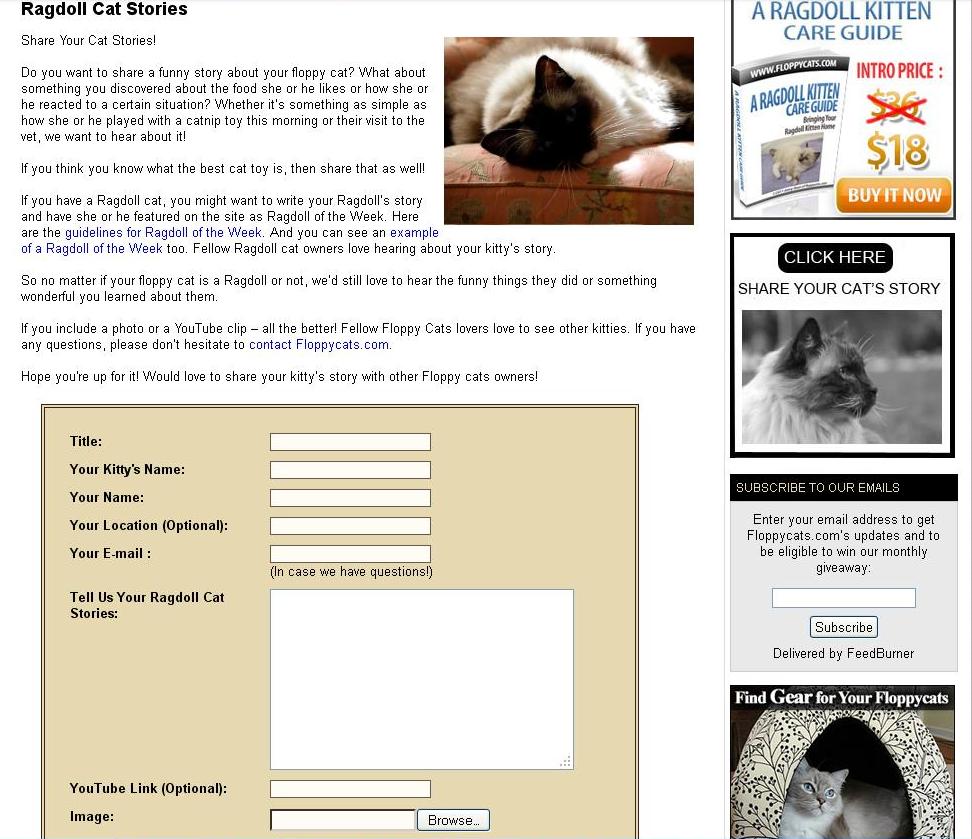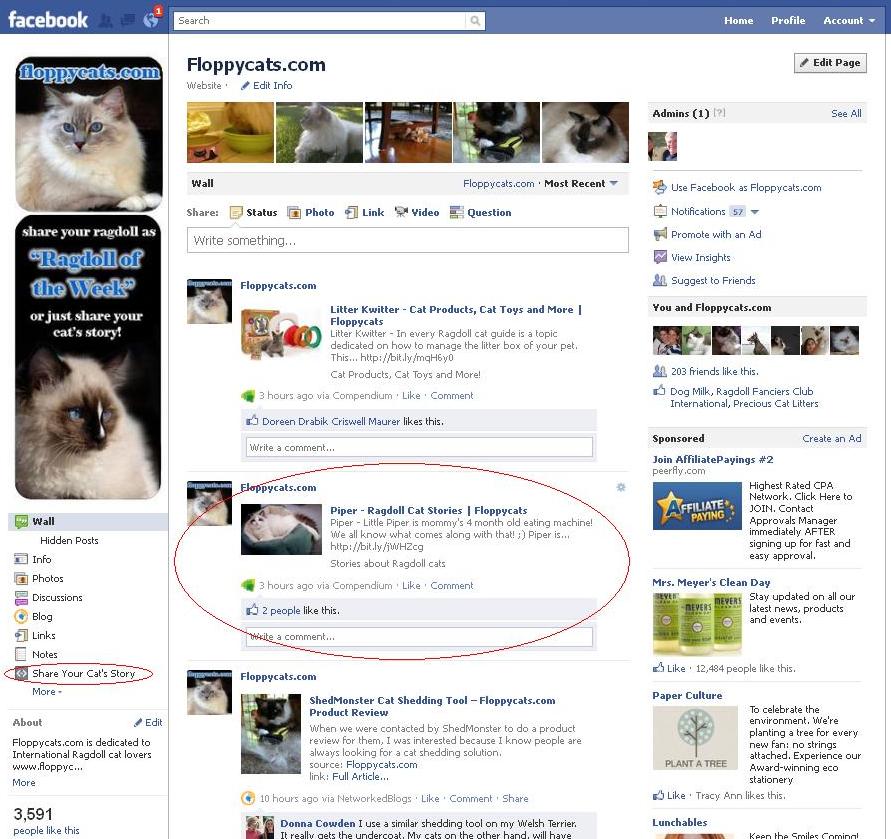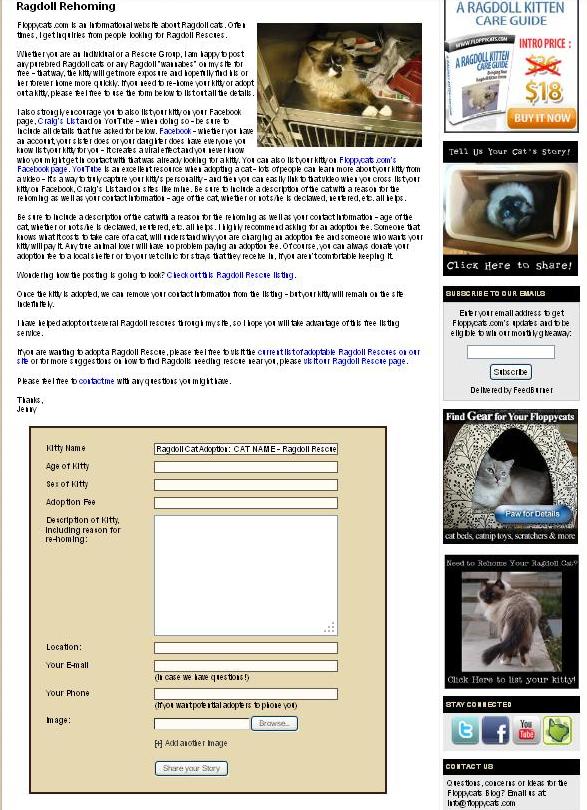 | Make Money Online http://www.problogger.net рекомендовать друзьям >> |
- How Compendium's Web to Post Generates Content and Community
This guest post is by Jenny Dean of Business Blog Writers.
You might have read my article about a business blogging platform called Compendium. Today, I wanted to share with you a fantastic Compendium tool called, Web to Post that allows customers or clients to tell stories about your products or services.
Web to Post turns your consumer’s advocacy into web content.
Of course, as Business Blog Writers, sometimes this writes us out of the picture, but at the same time, if we are used to supplement the Web to Post content, then we can also get a lot of content ideas from what customer or clients submit.
In addition to my blog writing business, I also have a Ragdoll cat blog and all images of Compendium’s Web to Post form come from that.
How does Web to Post work?
A Call to Action is put in the sidebar of the blog. The CTA usually says something like, "Share Your Story".
This call to action can also be put on your Facebook fan page, in your newsletter, on your YouTube Channel or in an email to an existing database.
The customer sees the CTA and decides to submit a story. They click on the link and are taken to an online form that asks them things like their story title, the story, and their first and last name. They can also choose to upload a photo to include with their story. The forms are totally customizable to fit your campaign or story needs.
Once the stories are received, the administrator of the blog is sent an email letting him or her know there is content waiting in the system. The stories can be edited, approved or declined from there, just like internal blog posts on Compendium's system. So in other words, the story isn't instantly on your company website the second the customer or client hits "submit". Rather, it has to go through an administrative layer for final approval. This is awesome, because it turns your advocates into your bloggers! [Share Your Story Submission on Dashboard.jpg]
Once the administrator has checked out the post and added a keyword rich title, then the admin approves it. At that point is the Compendium algorithm automatically categorizes or tags the story to the relevant, targeted keyword pages on your blog . The admin can also choose to promote it on your company's social networks, like Twitter, Facebook, and LinkedIn.
Then, the viral effect kicks in. Each story is published on your company's blog, Facebook, Twitter, and LinkedIn pages.
The customer who submitted the story also gets an automatic email that says their story has been published on your company's blog. Another link encourages them to share their featured story on their own social network profiles.
How Web to Post helps business blogs
Lee Jorgenson, an Account Manager at Compendium recently pointed out that Sears Outlet has generated over 5,000 posts in just three months by gathering content from five different channels.
Sears Outlet sends a great transactional email after someone purchases from their website that invites customers to share their stories. This email is timely and helps harvest stories while they are fresh in the customer's mind. The email has a link that drives the customer to a web to post form to submit their story. They also use the Web to Post forms to capture stories from blog and website visitors. They also have one embed on their Facebook fan page tab and collect stories from Facebook fans that way.
The process is simple: Content → Exposure → Referrals → Sales
Another Compendium client, The College Network, was able to launch a contest asking nurses to share their stories. The prize? An iPad. They received nearly 100 user generated stories (that's 100 free posts!). The stories got over 40 comments and over 1,500 Likes. They drove 3,500 unique visits to their story page and tracked an average of 35 additional Facebook fans per day from the campaign. It also increased their organic search traffic by 25%—all for the cost of an iPad.
How Web-to-Post helps smaller bloggers
As far as my site, Floppycats.com, is concerned, Web to Post has made my life incredibly easier. When I run a giveaway, I tell people that for an extra chance to win the prize, they can submit a photo of their cat as well as a description explaining why their cat needs to win the product.
This approach not only generates more activity on my site, but also creates more content for my blog. And readers love to see photos of their cats on my blog!
I also use Web to Post for Ragdoll breeders who want to advertise kittens for sale. It saves me the time involved in uploading them to the site, and entering all the information—and they’re hosted on Compendium's server, not the one I am paying for.
I also use Web to Post to accept content from people who need to rehome their Ragdoll cats, and cat rescue groups that need to get the word out about cats available for adoption.
I give a lengthy explanation of what I want (this eliminates time-consuming emailing back and forth between the poster and me) and provide examples so readers know what information they need to submit.
So while Web to Post is great for sales and boosting social media buzz about your company, for the blogger who wants an active online community on their blog, Compendium's Web to Post can also make your life a lot less busy. Just say “no” to too much right- and left-clicking!
What if you don't have compendium?
If you don't have Compendium, you can probably still put something like this together, but it would require more manpower and coordination to get it done.
Frankly, I don't like to spend my time on the technicalities and would rather have it right from the get-go. Compendium's business blogging platform simply takes care of the strategy, process and technology so your business can focus on the content and stories.
Jenny Dean is a 31-year-old-business owner and entrepreneur from Kansas City. Jenny is currently working on Business Blog Writers, a company that supplies blog content specifically for company's blogs, Floppycats.com, an informational website about Ragdoll cats and Antioxidant-fruits.com, an informational website about the antioxidant powers of fruit. Follow Business Blog Writers on Twitter or on Facebook.
Originally at: Blog Tips at ProBlogger

How Compendium's Web to Post Generates Content and Community

Переслать - Is Shared or Dedicated Hosting Best for You?
This guest post is by Jesse of Professional Intern.
Blog owners have a lot of decisions to make if they want to be successful. What will my blogs focus be? What audience do I want to target? Should I use a formal tone or a more personal one?
One of the questions to which blog owners rarely give enough thought is what kind of web hosting solution they’ll use. In this article, I’ll explain the differences between shared and dedicated servers, as well the benefits that each can offer you and your blog.
Shared hosting
Shared web hosting is the lowest cost hosting option available. With this type of hosting, your server is basically one of many server programs run on a single piece of hardware. You share physical resources with other clients whose servers also inhabit the same machine.
This spreads out the cost of hardware, bandwidth and maintenance among all of the hosts clients, but it also means that each client only gets a portion of the power and speed of the server, which can significantly degrade performance if one or more of the clients starts using more resources.
If, for instance, your site is hosted on a shared server and begins attracting significantly more visitors than normal, the performance of the other sites on the server will be degraded and, eventually, your site may be temporarily deactivated to reduce the strain on the server and its impact on other clients.
Customizing a shared server
Most shared web hosting services offer simple, one-click management options for their servers. While this makes it easy to set up a basic WordPress or Drupal blog, the options are often limited to whatever the host decides to support and, often, more extensive customization is not available.
With this specialization, however, often comes better customer support. Because the host carefully chooses the programs and options available, they’re better able to serve their users.
While shared web hosting can be a great choice for blogs that are intended to be personal and small, if you want to grow your blog, host multiple blogs or begin offering additional content, like forums, you’ll need to start considering a switch to a dedicated server.
Dedicated hosting
Dedicated servers offer a wealth of benefits you can’t receive with shared servers, but they do have one major drawback: increased cost.
Even a moderately-priced dedicated hosting package can cost upwards of $99 per month. If you add on management, technical support, a firewall or upgrade to a more powerful server, the price can increase dramatically. A powerful, fully-configured, managed and serviced dedicated server will often cost over $1000 per month.
How can that kind of expense be worth it to a blog owner?
Reliability and security
The biggest advantages of dedicated hosting are increased speed, reliability, security, and control. If you’re not sharing resources with other clients, you won’t have to worry about their sites slowing down your site’s load times and degrading your site’s user experience.
Further, because the server won’t be split among multiple clients, there’s less of a chance of it experiencing a critical failure that could take your site down.
Hosting your site on its own server also results in fewer security vulnerabilities. If you share a server with someone who doesn’t practice good security measures, your site is vulnerable, too; on a dedicated server, however, your site’s security rests on your choices, not those of another user you may never meet.
With a dedicated server, you’re in control
Having a dedicated hosting plan gives you far more control than a shared plan would. After choosing your server’s operating system, you may have as much or as little control of the workings of your server as you desire. Unless you wake up every morning excited about server administration, you may want to look into either hiring someone to perform those duties for you, or look into a managed hosting plan on your server.
Many hosts will give you several levels of management options, ranging from little user intervention to full user configuration. The more control you give someone else over your dedicated server, the more you’ll end up paying, but it can definitely be in your best interest to let someone with experience in server administration handle those tasks for you.
In addition to multiple levels of control, you’ll be able to choose which features you want to include on your site. Generally speaking, the more features you want on your site, the better off you’ll be with a dedicated server.
When to switch to dedicated hosting
If you already have a shared web hosting plan, you might be wondering when it would be most beneficial to switch to a dedicated host. If you’ve noticed an increase in user complaints about slow server response times, degraded performance or an inability to access your site reliably, that’s a good indication that it’s time to start looking into alternate hosting.
Also, if you’ve been experiencing a marked increase in traffic, you might want to switch to a dedicated server to head off any capacity problems you might experience if your growth continues. As I previously mentioned, if you plan on adding more advanced features to your site, you should definitely consider a switch from shared hosting.
Who needs a dedicated server?
Basic shared web hosting is a great choice for a new or amateur blog, but if you’re planning on getting serious with your site, you’ll probably end up needing a dedicated server at some point.
Shared servers often end up slow, crowded and vulnerable, in addition to leaving you with few options for control. Dedicated servers, while the more expensive option, feature none of those drawbacks and give you as much performance as you need. You also have a wider range of options for control over your site’s server.
If you desire a faster, more reliable site or want to add many advanced features, you should seriously consider switching to a dedicated server. Your users will have a much better experience and you’ll likely end up dealing with fewer performance issues.
How’s your blog hosted? Have you transitioned from shared to dedicated hosting? Tell us about your experiences in the comments.
Jesse L. is a recent college graduate who blogs at http://www.professionalintern.com and enjoys all things social media and Apple-related.
Originally at: Blog Tips at ProBlogger

Is Shared or Dedicated Hosting Best for You?

Переслать - What Drama Musicals Can Teach Us About Great Blog Writing
This guest post is by Achim "Chef Keem" Thiemermann of MusicalWorkshop.org.
As the US webmaster and social media manager of Europe's most successful musical librettist and lyricist, Dr. Michael Kunze, I am intimately familiar with his unique brand of storytelling: the drama musical. To this day, Michael's combined works (original musicals and foreign-language adaptions) have sold 33 million tickets for a whopping $1,012,000,000! He must be doing something right. Right?
Just a few weeks ago I started thinking about the similarities between blogging and writing a musical play: in both instances we are striving to elicit emotion from our audiences, which in turn shall motivate them to take some kind of action.
Whether they are theater goers or blog visitors, it is the art of telling a good story that makes all the difference in their response to our pitch.
Michael Kunze has some intriguing insights on storytelling:
"I am a storyteller by profession, although I started out as a songwriter. When I had stories to tell that would not fit into the tiny format of a song, I became a dramatist for the musical stage. By studying the elements of successful musicals, I soon found out that they all were based on the same kind of structure."
"And I discovered something surprising … the story is primarily told through its structure. Quite a blow for someone who believes in the power of words and sentences!"
"Over the years I've developed a very distinct structure for my drama musicals. So far I've written five original shows, and each one has become an international success. Altogether, they have reached more than 15 million people. I have no doubt that I owe this success to the fact that my musicals are better structured than most."
Let's take a closer look at Michael's method of telling a good story.
The basic structure of a drama musical
- In the beginning we learn about the protagonist's (hero’s) desire to achieve a certain goal.
- Facing powerful antagonistic forces, our hero initially descends into a "hole" with seemingly insurmountable obstacles.
- To recover from all kinds of setbacks, and to continue on the path to fulfillment, he must overcome one or more of his character flaws.
- As the story unfolds, the protagonist encounters a number of dramatic turns and surprising twists, which further illustrate his or her different stages of progress.
- After a key experience toward the end of the story, our protagonist has learned his lessons and thus become a better person. He is now ready to complete his journey.
So, what if you applied the principles of successful musical dramas to your writing?
You are the protagonist in your blog posts!
In writing as protagonists and describing your experiences with products, travel tips, online tools, recipes, personal growth issues, or whatever topic you're blogging about—your stories must fascinate the readers through an emotional ride from a troubled beginning to a satisfactory ending.
Help your audience identify with you—the hero of your story. Ask these questions:
- Which obstacles had originally kept you from achieving your desired end results? Was it shyness, ignorance, pride, indecisiveness, procrastination, or lack of self-esteem?
- What did you have to do to remedy your situation? Stand up against nay-sayers (including yourself)? Put in some extra work through research and courses? Let go of old habits? Push through your "dip"?
- What were some of the milestones signifying your continuing progress? What motivated you to keep going in the face of adversity? Which insights confirmed that you were on the right path?
- What major personal break-through did you experience in the end? What did you learn about yourself that took you to the desired level of success?
- Now that you have achieved your goals, how can your readers benefit from your efforts? How can you solve their problems or make their lives better and easier? What is your extraordinary gift to your audience?
Why story structure is important
Michael's additional words of advice:
"Most of us tend to write as we talk—unstructured. But blogging is not so different from other forms of writing. To grab the reader’s interest give him a story. A story with a beginning, a middle, and an end."
"Even better: A story with one or two surprising twists that keep the reader curious and wanting to know the ending. And, make sure that you know the ending before you start writing."
Actually quite simple, isn’t it? Do you use storytelling structure in your blog posts?
Achim "Chef Keem" Thiemermann manages MusicalWorkshop.org, Michael Kunze's English-language website. He is also a co-founder of the new revenue-sharing writers' platform called Wizzley.com.
Originally at: Blog Tips at ProBlogger

What Drama Musicals Can Teach Us About Great Blog Writing

Переслать
 | Культура, Искусство, Арт - статьи и фото Лучшие статьи и фотографии по темам: Арт, Фотография, Дизайн, Архитектура, Интерьер, Мода, ХэндМейд, Кино, Литература и т. д. Присоединиться → |
| rss2email.ru |
| rss2email.ru | отписаться: http://www.rss2email.ru/unsubscribe.asp?c=12354&u=1052515&r=672244627 управление подпиской: http://www.rss2email.ru/manage.asp партнерская программа: http://partner.rss2email.ru/?pid=1 |










Комментариев нет:
Отправить комментарий